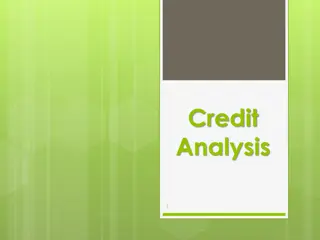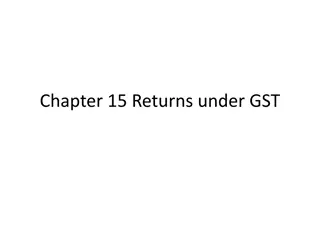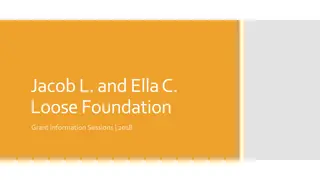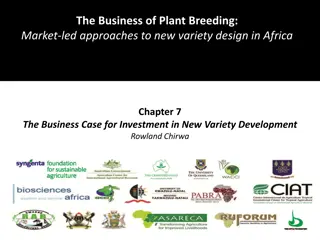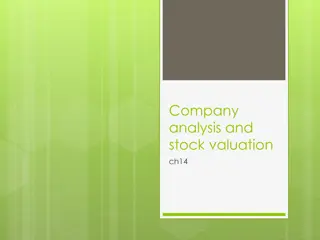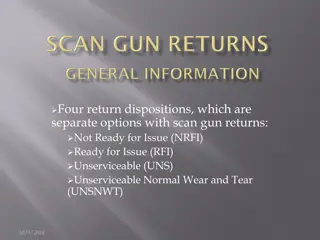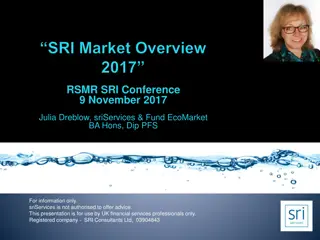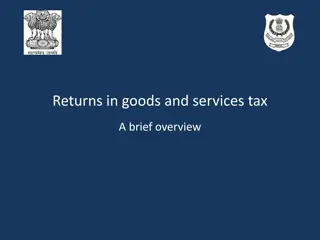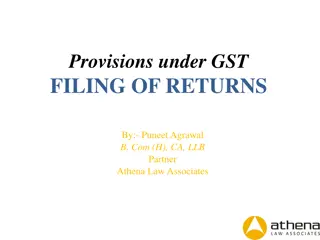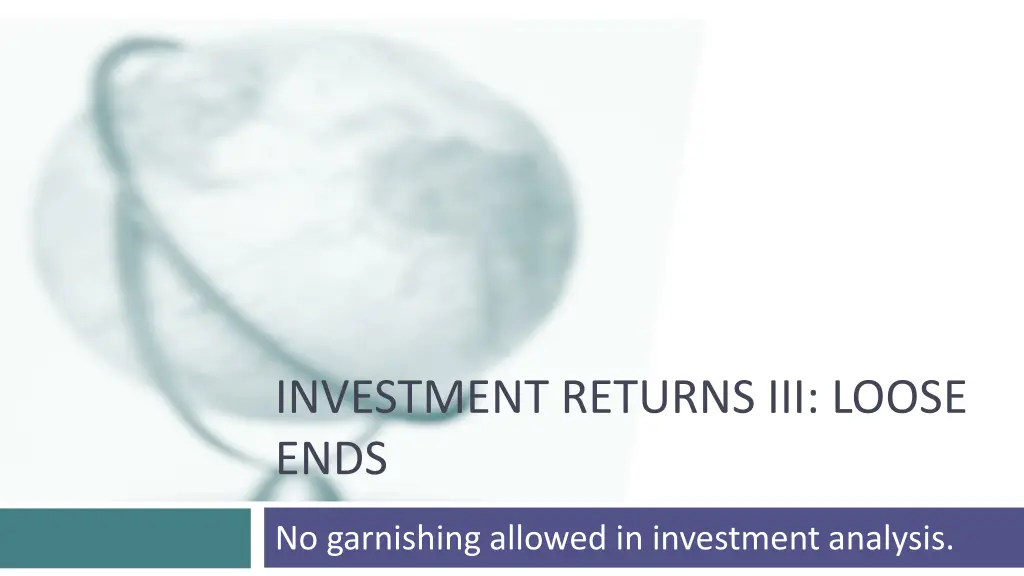
Corporate Finance Analysis: Investment Returns and Uncertainty
Explore the world of corporate finance through investment analysis focusing on returns, risk assessment, financing decisions, and dividend policy. Understand the impact of currency exchange rates, project uncertainties, and valuation methods in financial decision-making. Dive into the nuances of assessing value and making strategic investment choices in a dynamic market environment.
Download Presentation

Please find below an Image/Link to download the presentation.
The content on the website is provided AS IS for your information and personal use only. It may not be sold, licensed, or shared on other websites without obtaining consent from the author. If you encounter any issues during the download, it is possible that the publisher has removed the file from their server.
You are allowed to download the files provided on this website for personal or commercial use, subject to the condition that they are used lawfully. All files are the property of their respective owners.
The content on the website is provided AS IS for your information and personal use only. It may not be sold, licensed, or shared on other websites without obtaining consent from the author.
E N D
Presentation Transcript
INVESTMENT RETURNS III: LOOSE ENDS No garnishing allowed in investment analysis.
Set Up and Objective 1: What is corporate finance 2: The Objective: Utopia and Let Down 3: The Objective: Reality and Reaction The Investment Decision Invest in assets that earn a return greater than the minimum acceptable hurdle rate The Financing Decision Find the right kind of debt for your firm and the right mix of debt and equity to fund your operations The Dividend Decision If you cannot find investments that make your minimum acceptable rate, return the cash to owners of your business Hurdle Rate Financing Mix 4. Define & Measure Risk 5. The Risk free Rate 6. Equity Risk Premiums 7. Country Risk Premiums 8. Regression Betas 9. Beta Fundamentals 10. Bottom-up Betas 11. The "Right" Beta 12. Debt: Measure & Cost 13. Financing Weights Dividend Policy 17. The Trade off 18. Cost of Capital Approach 19. Cost of Capital: Follow up 20. Cost of Capital: Wrap up 21. Alternative Approaches 22. Moving to the optimal 24. Trends & Measures 25. The trade off 26. Assessment 27. Action & Follow up 28. The End Game Financing Type 23. The Right Financing Valuation 29. First steps 30. Cash flows 31. Growth 32. Terminal Value 33. To value per share 34. The value of control 35. Relative Valuation Investment Return 14. Earnings and Cash flows 15. Time Weighting Cash flows 16. Loose Ends 36. Closing Thoughts
Rio Disney: The US Dollar Assessment Discounted at Rio Disney cost of capital of 8.46% 3
Does the currency matter? The analysis was done in dollars. Would the conclusions have been any different if we had done the analysis in Brazilian Reais? Yes No a. b. 4
Disney Theme Park: $R NPV Expected Exchange Ratet = Exchange Rate today * (1.09/1.02)t Discount at $R cost of capital = (1.0846) (1.09/1.02) 1 = 15.91% NPV = R$ 7,745/2.35= $ 3,296 Million NPV is equal to NPV in dollar terms 5
Uncertainty in Project Analysis: What can we do? Based on our expected cash flows and the estimated cost of capital, the proposed theme park looks like a very good investment for Disney. Which of the following may affect your assessment of value? Revenues may be over estimated (crowds may be smaller and spend less) Actual costs may be higher than estimated costs Tax rates may go up Interest rates may rise Risk premiums and default spreads may increase All of the above How would you respond to this uncertainty? Will wait for the uncertainty to be resolved Will not take the investment Ignore it. Other a. b. c. d. e. f. a. b. c. d. 6
One simplistic solution: See how quickly you can get your money back If your biggest fear is losing the billions that you invested in the project, one simple measure that you can compute is the number of years it will take you to get your money back. 0 -$2,000 -$2,000 1 -$1,000 -$3,000 2 -$859 -$3,859 3 -$267 -$4,126 4 $340 -$3,786 5 $466 -$3,320 6 $516 -$2,803 7 $555 -$2,248 8 $615 -$1,633 9 $681 -$952 10 $715 -$237 11 $729 $491 12 $743 $1,235 13 $758 $1,993 14 $773 $2,766 15 $789 $3,555 16 $805 $4,360 17 $821 $5,181 Year Cash Flow Cumulated CF PV of Cash Flow -$2,000 -$922 -$730 -$210 $246 $311 $317 $314 $321 $328 $317 $298 $280 $264 $248 $233 $219 $206 Cumulated DCF -$2,000 -$2,922 -$3,652 -$3,862 -$3,616 -$3,305 -$2,988 -$2,674 -$2,353 -$2,025 -$1,708 -$1,409 -$1,129 -$865 -$617 -$384 -$165 $41 Payback = 10.3 years Discounted Payback = 16.8 years 7
A slightly more sophisticated approach: Sensitivity Analysis & What-if Questions The NPV, IRR and accounting returns for an investment will change as we change the values that we use for different variables. One way of analyzing uncertainty is to check to see how sensitive the decision measure (NPV, IRR..) is to changes in key assumptions. While this has become easier and easier to do over time, there are caveats that we would offer. Caveat 1: When analyzing the effects of changing a variable, we often hold all else constant. In the real world, variables move together. Caveat 2: The objective in sensitivity analysis is that we make better decisions, not churn out more tables and numbers. Corollary 1: Less is more. Not everything is worth varying Corollary 2: A picture is worth a thousand numbers (and tables). 8
The final step up: Incorporate probabilistic estimates.. Rather than expected values.. Actual Revenues as % of Forecasted Revenues (Base case = 100%) Country Risk Premium (Base Case = 3% (Brazil)) ? Operating Expenses at Parks as % of Revenues (Base Case = 60%) ? ? 10
The resulting simulation Average = $3.40 billion Median = $3.28 billion ? NPV ranges from -$1 billion to +$8.5 billion. NPV is negative 12% of the time. 11
A side bar: Should you hedge risks? Disney can reduce the risk in this project by hedging against exchange rate risk. Should it? Yes No Maybe a. b. c. 12
Value Trade Off Cash flow benefits - Tax benefits - Better project choices What is the cost to the firm of hedging this risk? Negligible High Survival benefits (truncation risk) - Protect against catastrophic risk - Reduce default risk Is there a significant benefit in terms of higher cash flows or a lower discount rate? Is there a significant benefit in terms of higher expected cash flows or a lower discount rate? Discount rate benefits - Hedge "macro" risks (cost of equity) - Reduce default risk (cost of debt or debt ratio) Yes No Yes No Can marginal investors hedge this risk cheaper than the firm can? Hedge this risk. The benefits to the firm will exceed the costs Indifferent to hedging risk Do not hedge this risk. The benefits are small relative to costs Pricing Trade Earnings Multiple - Effect on multiple Earnings - Level - Volatility X Yes No Hedge this risk. The benefits to the firm will exceed the costs Will the benefits persist if investors hedge the risk instead of the firm? Yes No Hedge this risk. The benefits to the firm will exceed the costs Let the risk pass through to investors and let them hedge the risk.
A final thought: Side Costs and Benefits Most projects considered by any business create side costs and benefits for that business. The side costs include the costs created by the use of resources that the business already owns (opportunity costs) and lost revenues for other projects that the firm may have. The benefits that may not be captured in the traditional capital budgeting analysis include project synergies (where cash flow benefits may accrue to other projects) and options embedded in projects (including the options to delay, expand or abandon a project). The returns on a project should incorporate these costs and benefits. 14
First Principles Maximize the value of the business (firm) The Investment Decision Invest in assets that earn a return greater than the minimum acceptable hurdle rate The Dividend Decision If you cannot find investments that make your minimum acceptable rate, return the cash to owners of your business The Financing Decision Find the right kind of debt for your firm and the right mix of debt and equity to fund your operations The hurdle rate should reflect the riskiness of the investment and the mix of debt and equity used to fund it. How much cash you can return depends upon current & potential investment opportunities The return should relfect the magnitude and the timing of the cashflows as welll as all side effects. How you choose to return cash to the owners will depend whether they prefer dividends or buybacks The optimal mix of debt and equity maximizes firm value The right kind of debt matches the tenor of your assets 15
Task Read Chapter 6 Draw up a risk profile for your company & make a judgment on which risks, if any, you would hedge. 16








